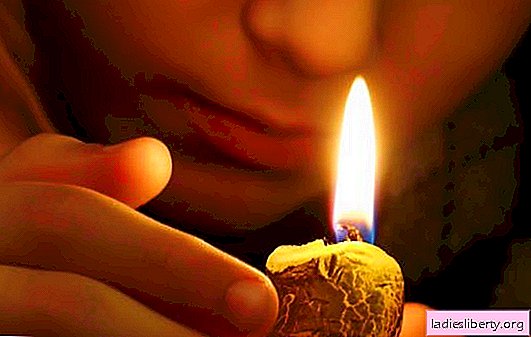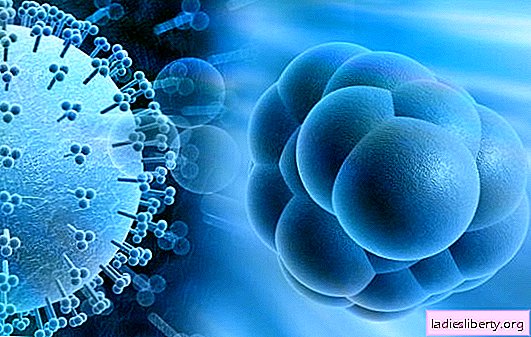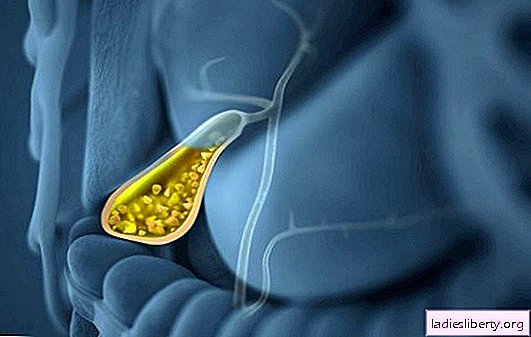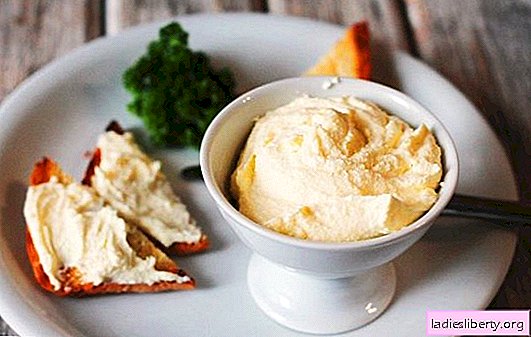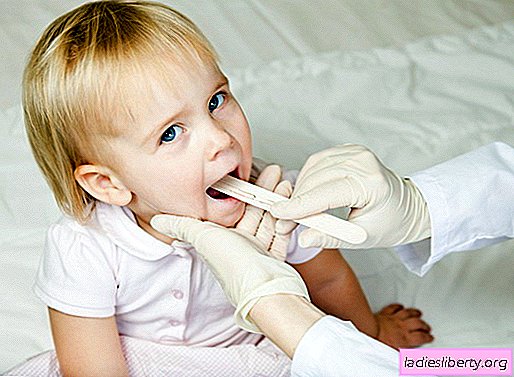
They fed the baby, he is satisfied, but small white “spots” are visible in the mouth? Most often, mummies consider such whitish footprints to be just food debris, so they don’t worry about this.
In the end, the child eats the first months of life mainly with mother's milk, so why not stay in his mouth after him. However, "milk food" and white plaque in the mouth are connected only by the similarity of names - thrush, and these are not the remains of milk, but colonies of Candida yeast-like fungi.
The outward resemblance of plaque with droplets of milk in the baby’s mouth and the persistence of this phenomenon lead the mothers to bewilderment, and the restless behavior of the baby during feeding makes him consult a pediatrician. The diagnosis made by the doctor is candidal stomatitis, colloquially - thrush.
The baby becomes restless, capricious for no reason, can refuse to breast or bottle during feeding while remaining hungry, which will cause additional crying. The sucking process causes pain, so the baby sometimes does not even try to take the breast. If you do not interfere with the disease process, then small plaques will begin to grow, a whitish film or even a curd-like coating will appear.
Distinctive properties of thrush from ordinary residues of milk or milk mixture on the oral mucosa
- whitish spots (plaques) appear not only on the gums or palate of the child, but also on the inside of the cheeks
- it is impossible to remove the plaque with a napkin or cotton swab, and if this is achieved, then after removing the whiteness there will remain inflamed reddish spots
- the baby loses his appetite, eats poorly, often cries with food
- the child’s sleep becomes restless, it is impossible to calm the crying with food or motion sickness
Causes of thrush in the mouth of a child
Every mom needs to know that Candida's yeast-like mushrooms exist independently of us in any organism, including the body of a newborn too. Their small colonies exist on the mucous membranes all the time, and the fact that the disease does not progress, we owe our immune system, a well-developed microflora.
It is it that does not allow fungi to multiply on our skin, but babies do not have such strong immune defenses, therefore under adverse conditions the yeast infection develops very quickly, capturing more and more spaces, causing irritability and tearfulness in the child.
The absence of benign microflora in the baby leads to the rapid progression of the disease, and the child can even “get” thrush from the most loving person through a kiss or touch with his hands.
One of the causes of thrush in a child is the presence of thrush in mom, which transmits the disease when feeding or caring for a newborn. You can notice the signs of candidiasis already in the first days of the baby's life, since a whitish coating will immediately appear on the internal mucous membrane of the mouth.
In the premises of maternity hospitals, a temperature that is comfortable for mothers is maintained, but the hot and dry air of the room can provoke the growth of candida colonies. If the baby is crying, if it has a small runny nose that causes active oral breathing, the mucous membrane of the newborn’s oral cavity dries quickly.
This serves as an excellent "field" for seedlings of Candida fungus, therefore, to reduce the possibility of developing the disease, it is necessary to maintain a humidity of at least 40-60% in the room where the child is. Prevent frequent crying of the child so that saliva is constantly present in the mouth, the substances of which inhibit the growth of the fungus.
Additional causes of thrush in the mouth
There are concomitant reasons that can also give impetus to the development of thrush - this is the underdevelopment of the mucous membrane of the child’s oral cavity, wounds or cracks in the corners of the mouth, frequent abnormal regurgitation, treatment with antibiotics or other strong medications. All drugs that in any way weaken the immunity of babies contribute to the development of thrush, and this should be considered when prescribing treatment for newborns.
In addition, children who are premature before the term of birth, children on artificial feeding, and the reason, again, are the undeveloped immunity of children. Premature babies are more likely to be affected than babies who are full-term before the term of birth, and premature babies are more severely affected by thrush. Artificial feeding children for the same reason are more likely to get thrush than children whose mothers breastfeed, even when the mother is obviously ill with candidiasis. Along with the stimulation of the disease, mothers transmit a positive microflora, which prevents the disease in the child from entering the active phase.
If we take into account the rapid development of the child, then the causes provoking thrush can be teething, dysbacteriosis, severe colds with stuffy sinuses; non-observance by mother of special hygiene rules (processing of mammary glands), boiling bottles for milk, washing toys that a child puts in his mouth and so on. Quite often, the provocateur of the development of thrush is sweetened water or a milk mixture, since fungi actively develop in a sweet environment.
The danger of thrush in the mouth for the development of the child
A whitish coating in the child’s mouth with thrush hides a more serious danger - this is a fatty coarsening of the mucous membrane, which can bleed. The penetration of infection into such cracks is quite possible, and then it will be necessary to treat not only thrush, but also more serious diseases. If the thrush is neglected, then the entire oral cavity of the baby is covered with a dense film that passes into the throat. Gums and even lips begin to bleed, and the child cannot make sucking movements, he is constantly malnourished and crying, which provokes the further development of the disease.
A simple way to treat a baby's thrush in her mouth
Some pediatricians are sure that for the treatment of thrush in newborns do not need special conditions, it is enough to maintain a comfortable temperature in the house, and not give the child a lot of crying. Humidity should always be within normal limits, but not exceed the threshold of "mold" mold, that is, 75-76%.
The child should have clean nasal breathing, in a dream the baby should breathe with his nose, and not his mouth, so that the mucous membrane of the mouth does not dry out. For the treatment of thrush, the absence of cracks in the mouth and dryness are sufficient, and this in itself will lead to the cessation of the growth of fungal colonies, the whitish coating will disappear. Not instantly, but quickly enough, everything will return to normal.
Of course, there is one significant nuance that pediatricians should take into account - the child’s immune system should already be strong enough, otherwise you can’t do without antifungal therapy.
Drug treatment of candidal stomatitis
First of all, do not panic, the thrush, even the most neglected, is treated! Make it a rule to carry out all the procedures that the pediatrician will prescribe daily and systematically, and your child will be healthy. Most drugs for treating thrush are nystatin-based drugs, and everything will depend on the patience of the mother, who will need to process the baby’s mucous membrane over and over again.
If white spots in the mouth appear on weekends, you can alleviate the painful sensations of the child with soda (a teaspoon in a glass of warm water) or honey (2 teaspoons in a glass of water) solution, wetting in which the baby’s mouth is treated 4-5 times a day .
In no case do not self-medicate the child, show the baby to the doctor and use only the doctor's prescriptions when treating thrush. If the thrush is only in the initial stage, then all treatment will consist in the surface treatment of the foci of inflammation in the baby's mouth. Treat the plaques with a sterile cotton swab or stick using a soda solution or a solution of hydrogen peroxide (only as directed by a doctor!). Then you need to treat the infected surface with a solution of nystatin or a solution of clotrimazole (pharmacy solution).
Mom must undergo a course of treatment for candidiasis, otherwise the thrush in the child will return again. Only with the low effectiveness of such treatment, antifungal antibiotics can be prescribed for the baby by the doctor.
Treatment of thrush is a long process, so the first signs of recovery can appear only at the end of the first week of treatment, which must be continued until all painful manifestations disappear completely.


